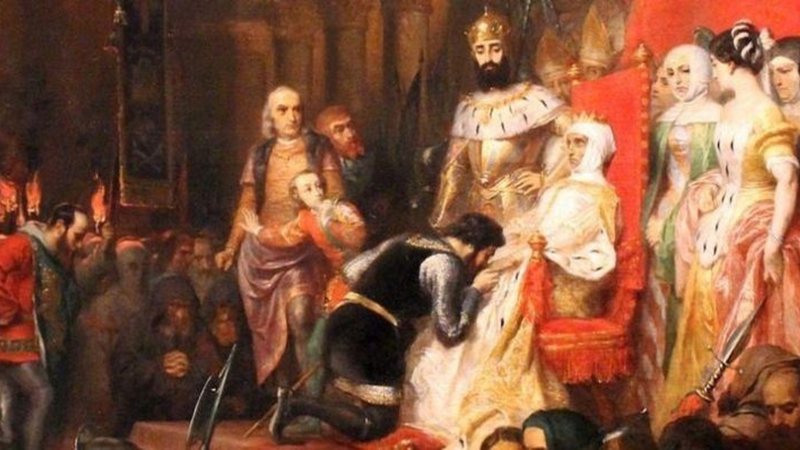The story of the Dead Queen is a secondary episode in the history of Portugal, but it is so amazing that it has given rise to many legends, books and plays.
Ines de Castro, and the young Prince Peter of Portugal.
Ines de Castro, born in 1325 in Coimbra (Northern Portugal), came from one of the most powerful families in Castile. At the age of 14, she was placed as a lady-in-waiting to Constance of Castile, who was promised to Peter of Portugal, the heir to the Portuguese crown.
As in all great tragedies, the story begins with a love story: Prince Peter of Portugal falls in love with Ines de Castro and neglects his bride, Constance.

Pedro e Inês
The Prince's father, King Alfonso 4, disapproved of this affair mainly for reasons of power. Indeed, Ines' relatives also became friends of the young Prince and the "Clan of Castro" extended its influence.
In 1344, he exiled Ines Castro to the castle of Albuquerque (Spain), on the Castilian border. The two lovers then started an assiduous correspondence.

Castillo de Luna Albuquerque - Credit oliraf.com
At the same time, Princess Constance died giving birth to the future King Ferdinand I of Portugal. Peter, now a widower, called Ines back to the Court. Their relationship, out of wedlock, gave birth to 4 children who could then claim the Throne in case of Prince Ferdinand's death.
On its side, the "Clan of Castro" extends its power to the Kingdom of Castile, border of the very young Portugal by marrying the sister of Ines to the new King of Castile.
Peter and Ines refrained from intervening in these struggles for influence and settled in Coimbra in the palace of Santa Clara.
The murder of Ines de Castro.
After several attempts to keep the lovers apart, King Alfonso 4 feared that his son, under the influence of the "Clan of Castro", would take part in the Castilian political crisis that was still going on.
He then orders the assassination of Ines. Pêro Coelho, Âlaro Gonçalves and Diogo Lopes Pacheco, appointed to execute Ines, went to Santa Clara and, taking advantage of Peter's absence, murdered Ines on January 7, 1355.
The coronation of the Dead Queen.
Two years later, in 1357, Alfonso 4 died and Peter was crowned. He announced that he had secretly married Ines seven years earlier. This announcement, confirmed by witnesses, legitimizes his descent.
He then had the body of Ines dug up, dressed her in a purple cloak, a sign of royalty, and seated her on the throne of Portugal, forcing the entire court to come and kiss her hand.

The assassins are pursued and some of them are captured. The King will demand that their hearts be torn out of their chests while he witnesses the scene at a banquet.
The funeral of Ines.
A new funeral was then organized for Ines. They will be celebrated in the Monastery of Alcobaça where two splendid tombs will be built. Peter will join Ines in 1367.

Tomb of Ines de Castro, Monastère d'Alcobaça
Their tombs, side by side, were moved several times before being placed face to face. According to the legend, they will be able to look into each other's eyes when they wake up for the last judgment.

The works born from the story of the Dead Queen.
Many Portuguese and Spanish poems evoke the tragedy of the dead Queen, notably those of Camoens, famous Portuguese poet in the Lusiades.
Plays are also based on this legend. In particular that of Montherlant "The Dead Queen".

The Dead Queen, a play by Montherlant
Operas have been written in homage to Ines de Castro, including those of Zingarelli in Italy, Scartazzini in Germany and Matthews in England.
Finally, the cinema could not miss this story and Carlos Santos and José Leitão de Barros have adapted the legend on the big screen.


